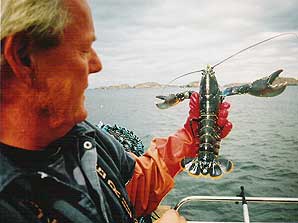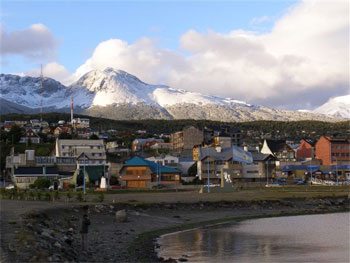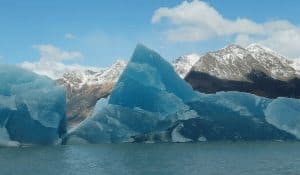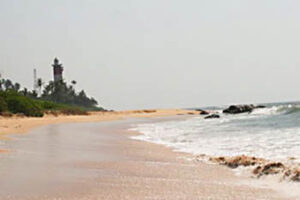The Scenery and Food of Tierra del Fuego
By David Rich

An electric day it was when I first heard about the uttermost ends of the earth, the gist of it all remaining a thrilling memory from way back when they still taught geography in school, about umpteen years ago.
The concept of a land beyond which there is none, a land of fires, of Tierra del Fuego, has fascinated me ever since my geography days as a wee tot. Four months of driving down from Ecuador and I finally made it to the bottom of South America.
Way Down
The Island of Tierra del Fuego is the size of South Carolina, or if you prefer, the size of Ireland, sitting at the tippy end of South America, the last outpost of civilization before arrival in Antarctica.
To the east of TdF rages the wild Atlantic, to the west and north the comparatively tranquil Straits of Magellan and to the south almost nothing across the Beagle Channel except Cape Horn. Here is where the most outrageous storms in the world collide.
TdF Island is easily conceivable in simple fourths, the west Chile and the east Argentina, the north windswept with dots of oil derricks, bogs and sheep in both Chile and Argentina, the south crammed with glaciers, jagged snow-capped mountains, a fabulous national park and the world’s southernmost city of Ushuaia.
What Was Once
The history of the fiery land is one of heartbreak and violent death. The four indigenous groups were slaughtered by Europeans to steal their lands for grazing sheep, making fortunes and building empires for the Europeans who still rule the land.
Less than ten survive from the Selk’nam tribe or any tribe, all over age 50 years, waiting in remote Puerto Eden, Chile, for their own final departure. I bought two pounds of king crab from one of these weather-beaten Selk’nam stalwarts, a quiet stoic chap, when the ferry from Puerto Montt to Puerto Natales anchored for a single hour at Puerto Eden (good luck on finding this remote burg on a map).
The southernmost Tierra del Fuegian tribe, the Yamana, lived naked in canoes, surviving the southern winds, rain, and cold by slathering seal fat over every square inch of their bodies, tending fires in their canoes. For these fires, Magellan named Tierra del Fuego, the land of fire. Darwin called the Selk’nam “among the most abject and miserable creatures I ever saw.”
Corduroy Dirt Roads
After stumbling across the windswept plains of Tierra Fuego for uncountable jouncy miles on corduroy dirt roads it was only slightly more jarring to see a pink church in a roundabout surrounded by pastel houses with white picket fences, smacking one right between the eyes like the similar town in Pleasantville, the movie. Cerro Sombrero is obviously way out of the way so stick with Argentinean Tierra del Fuego where the roads are mostly paved and the attractions abound.
A Silesian Mission sits six miles north of Rio Grande, Tierra del Fuego’s largest city of 60,000 people, the Mission now reduced to producing excellent cheeses and singing its own praises for altruism, for serving the local indigenous, graphically displayed in its tiny museum. The Mission has run out of indigenous to save, all Argentinean tribes having been extinct for nigh on eons and the last ten survivors now in Chile. But the cheese isn’t bad.
Huge Trout
Entering the wind-swept city of Rio Grande you’re confronted by an enormous 20 foot by 50-foot sculpture of a sea trout, so shocking that most tourists immediately stop to have their pictures takes in front, high red letters proclaiming Rio Grande to be the TROUT FISHING CAPITAL OF THE WORLD.
If you’re into huge sea trout weighing up to 24 pounds that themselves hook celebrities galore, then stop in Rio Grande as long as you can afford a license to fish.
A fishing license is only $100 a day and the catch limit is one trout a day but then the trout are matchlessly big honkers. You might be able to eat on one for about a month so as to recoup your investment. I continued to the heartland of Tierra del Fuego where the wind blows less than 50 MPH, to the heart of the heart, which is what Tolhuin means in the local dialect of extinct indigenous.
The Best Bakery in the World
Tolhuin is a tiny town on the east end of 50-mile long Lago Fagano and arguably boasts the best bakery in the world, a claim that gives me pause when trying sturdily to remember the tasty treats offered by bakeries on the left bank in Paris, those in Vienna and all over Switzerland. But then Tolhuin’s Panaderia la Union is open 365 days a year, 366 in Leap Years, to tempt you to cardiac hotel.
I was there on Christmas and New Year’s Days, cadging cappuccinos for $.37, almond bark bitter chocolate for $3 a pound and pastries in varieties too unfamiliar to list but in infinite assortments from fruit-filled to dark chocolate-dipped, eats to expire for, perhaps literally. Argentinean prices haven’t been so low for decades but slightly over a year ago they crashed, along with the dollar-denominated Peso.
Prices in Argentina are now the lowest in South America while less than two years ago they were the highest. Thus you simply must jet off now while you can afford conspicuous consumption at Panaderia la Union which also features a private zoo of exotic birds and an orphaned Guanaco, free hot water for yerba mate, the tea drunk compulsively and unceasingly by all Argentineans. Check it all out at this spanish website.
Journey’s End

In a blink, discounting 37 miles of extremely bad road, I was in, arriving in perfectly sunny weather (no wind) on Christmas Day, little kids trying out spanking new bicycles next to towering cruise ships on the spectacular waterfront, aka Beagle Channel.
This city of 40,000 extremely hardy souls is all superlatives, ringed by chilly black and white mountains, glaciers, extreme waters and parrillas, Argentinean pig-outs of meat featuring beef, lamb (better than in Greece or New Zealand!), pork and sausages, spreads to make the stoutest vegetarian blanch, relieved only by a veritable smorgasbord of anything you can think of from fish to pickled beets, $5.
The Argentinean currency crashed and you are the potential beneficiary/potentate, particularly in Patagonia because all basics are subsidized by the government from fuel to food, causing miniature sticker shock when one ventures too far north into regular Argentina.
Ushuaia has many charms from the Martial Glacier above it, within easy hiking or cable car distance, for great views of town and the Beagle Channel, to fabulous dining, T-shirts and souvenirs, the latter bragging “World’s End”, “Southernmost City” and the like.
But Ushuaia is much more than shallow fun, excellent resort hotels and views you must pay for. It has two fine museums, both rather kooky in their own way. The small Yamana Museum relates the tragedy of the indigenous in huge 3D pictographs and surviving photos. Indeed the Yamana did run around this frigid land naked, living on mussels, moving on weekly while tending the fires in their canoes. Chilling.
Tucked Away
The huge Maritime, Penal and Antarctica Museum is housed in a sprawling five-spoked penitentiary built by and for bad guys and political prisoners (from Russian Anarchist philosopher, Simon Radowitzky to a noted Argentine author, Ricardo Rojas). The maritime portion displays scale models of the important early explorers from Magellan to the Dutch, English and Portuguese.
A humongous map of Tierra del Fuego plots the literally hundreds of ships that have foundered and sunk on its shores, several promontories stacked up with over 30 sunken-ship symbols bearing the names of unfortunate vessels. The penitentiary part of the museum occupies two long spokes with dozens of rooms filled by engaging snippets (this chap killed kids for fun, another wrote best-selling books) and graphic vignettes with the prisoners in life-sized paper mache.
To a man they were incredibly fortunate to have been removed from frigidly and stormily isolated Staten Island, off the tip of Tierra del Fuego in the erratic Atlantic, removed in 1906 allowing them to exercise their building skills to erect a brand new five-spoked penitentiary. The museum details the most notorious murderers and the politically incorrect, plus providing gobs of info on the exploration of Antarctica, all of which takes at least two hours and less than $4.

75% of the World’s Ships
Ushuaia is the jumping-off place for Antarctica, the city from which 75% of the world’s ships leave for the frozen southland and which provides an outstanding opportunity for anyone to commandeer last-minute fares to Antarctica from $2000 and up and up and up, depending on the number of days.
The Antarctic peninsula is across the Drake Passage south of Cape Horn, two days from Ushuaia by ship. You can go by luxurious cruise ship, if you have a spare ten grand, or by expedition vessel, the latter principally Russian which have the most experience with Antarctic ice. I snagged 12 days for $3000 plus a 4% credit card surcharge.
Trip to Antarctica
Everyone will tell you that Antarctica is THE highlight of a lifetime but most of those who can afford to go have perhaps forgotten about the joys of sex. Actually my trip to Antarctica was rather climatic, but that’s a whole ‘nuther story.
My favorite pre-Antarctic part of Ushuaia was right next door at Tierra del Fuego National Park, $3 entrance fee, extending west to the Chilean border. The Park offers gorgeous lakes and coves, exquisite because glacier melt is cool in both color and pictures.
For some inexplicable reason our species seems to enjoy shades of bright neon blue. The lakes and the Beagle Channel are littered with exotic islands that sit below the final end-game of the snow-capped Andes as they run out of space after a 6,000 mile run down South America.
And you can climb the very end peak of the Andes, Cerro Guanaco, for views (weather permitting) to last a lifetime. Pictures from the top will show the Andes arching northward from their southernmost end, snow-capped all, above Lago Roca far below where they meld six miles away into impassible Chile. To the east is Ushuaia and the Beagle Channel and if you look closely Cape Horn is due south a mere 60 miles, the uttermost and final end of the earth.
Places to Stay and Eat in Rio Grande:
One top-notch accommodation caters to trout-fishing celebs: Posadade los Sauces (posadadelossauces@arnet.com.ar) ranging from $90 standard to $220 deluxe with Jacuzzi in the room, tricked out like the fancy fishing lodge it is. It’s bar is named ‘Achicona’ and is paneled in exotic dark woods, home to some of the most unbelievable fishing tales from anywhere on the planet. The Frederic Ibaria Hotel is $75 to $125 with breakfast, good restaurant and beds in the center of town.
Eat at Rueda (also in Ushuaia), which is excellent, all you can eat under $5 including slabs of beef and lamb and lots of sausage, good pasta and fish (of course). For all hotels in Tierra del Fuego with prices, detailed descriptions and email addresses for reservations see www.tierradelfuego.org.ar/rga/hotels.htm.
Places to Stay and Eat in Ushuaia:
I stayed at Alakaluf while awaiting my ship to Antarctica, private bath with breakfast included, sports room with harbor and mountain views and use of the kitchen, all in the heart of the city, a mere $20 so book early. But if I were to spend the bucks I’d land at Tolkeyen, 5 km from town (taxis are cheap), right on the Beagle Channel with a fabulous restaurant specializing in lamb and views to croak for, $50 to $65. Naturally, take a look at all the hotels listed at this website.
For eats in town the lamb and other meats at La Rueda are unparalleled for only $5, all you can eat, drinks extra running another couple of bucks for wine. On the waterfront street, Maipu, try Volver for décor, views and great food. Easy choices abound.
For vegetarians in Argentina, forget it, though there are two excellent supermarkets where you can pick up your fruit and veggie preferences, Norte on the near southside and La Anonima on the further NE side of Ushuaia.
Other Stuff: The only decent travel agency in Ushuaia for booking last-minute fares to Antarctica is Tourismo de Campo at 25 Mayo 76, email info@tourismodecampo.com.ar and say hi to Silvia, the consummate travel agent who will get you the best fare available with no shilly-shallying around, quite dissimilar from the other travel agents in town.
Internet places line both sides of the main street in Ushuaia, on San Martin, all between $.60 and $.90 an hour, several non-smoking.
Ushuaia
Sights around Ushuaia: These abound. Go to Estancia Harberton, open Oct 15 to April 15, founded in 1885 by Thomas Bridges, the first ranch in TdF. It contains the oldest house on the Island plus a copy of his son’s memoir, “The Uttermost Part of the Earth.”
Worth the trip alone is the Acatushun Bone Museum created by a biologist who married into the Bridges family, Natalie Prosser Goodall. The museum contains more than 2000 mammal and 2000 bird skeletons, most retrieved from Bahia San Sebastian north of Rio Grande where the 36 foot tide leaves marine animals stranded to bleach in the frantic TdF wind.
Across the Beagle Channel from Ushuaia lies the true end of the end, Puerto Williams, Chile, but since like most neighbors Chile and Argentina don’t much speak to each other much less allow visits, you can’t get there from Ushuaia, unless things change. Puerto Williams has 1800 people accessible by tour from Punta Arenas, Chile. Forget about getting there from Ushuaia, Argentina.
- Valentine’s Day Suggestions…for that Special Person - January 22, 2026
- Missouri Sports Travel Adventure: From Landmarks to Ballparks - January 21, 2026
- What First-Time Visitors Get Wrong About Visiting Iceland - January 15, 2026







